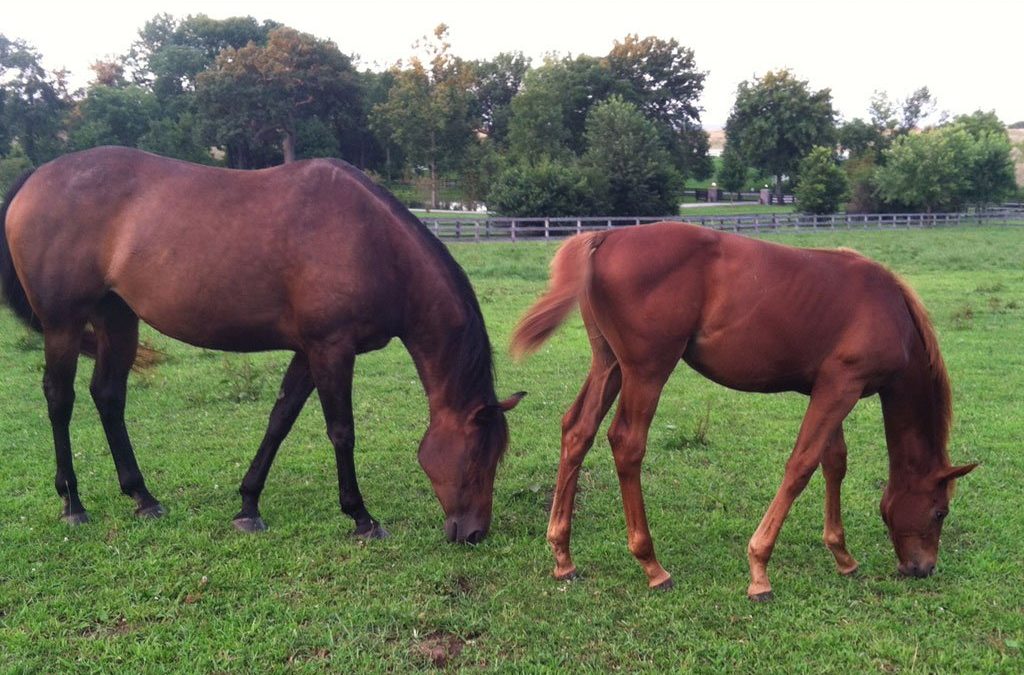As we head into fall, it’s time to plan for changes in the nutritional needs of your horses and those of the pastures they have been grazing. After a long hot summer, many pastures become overgrazed, overrun with weeds and possibly contain toxic plants. If there has been insufficient rainfall in your area, the entire pasture may be in poor condition. At this point, not much nutrition is available from the pasture for the horses grazing it, so alterations to their daily rations must be considered. Here are some tips on how to keep horses healthy on fall pastures and to help prepare the pasture for the next growing season.
The best way to keep pastures healthy and providing good quality nutrition is to prevent overstocking and when needed, rotate horses off pasture for six weeks to allow for adequate re-growth before reintroducing horses. In general, pastures that are stocked with more than 1 horse for every two acres will not be able to withstand grazing for much more than a couple weeks, especially during the dry fall season. Furthermore, if overstocked pastures become badly overgrazed, it is much more difficult and expensive to rehabilitate them with seeding and fertilizing. This type of pasture also tends to grow a variety of weeds and noxious plants. Hungry horses will eat whatever is available to them and this can be a problem if they ingest plants that are poisonous.
Therefore, if your pastures are overstocked, it is best to divide the pasture into several paddocks and graze the horses in each paddock until they have eaten it down to about two inches, then relocate them to the next paddock and continue doing this as needed. This can easily be done with electric portable fencing. Each paddock should get a rest of about 4-6 weeks depending on the weather conditions or until re-growth is 4 to 6 inches high. Spring and fall is the time when every pasture should be reseeded and fertilized based on the results of a soil test. Doing this twice yearly ensures the best possible growth and health of the pasture. If you are unsure how to go about seeding and fertilizing, check with your local farm store or the county extension agent.
It is also very important to drag the pasture with a chain harrow to break up the manure piles. This helps to kill parasite larvae as well as fertilize the pasture. Chain harrowing may need to be done once a week or so if the pasture is stocked with quite a few horses. A typical horse, which weighs about 1,000 pounds, produces between 45 and 55 pounds of manure per day, or around nine tons per year!
Horses that are sensitive to fructans and sugars in the grass, such as insulin resistant horses and those prone to laminitis and founder should be managed closely on fall pastures. Cool season grass growth will increase at this time due to colder temperatures at night. Grasses will concentrate sugars and fructans to prevent freezing, creating rapid growth in preparation for the dormant winter season. It may be best to muzzle sugar sensitive horses or withdraw them from pasture all together this time of year. Having a dry lot to put these horses in, helps manage their intake and controlled forage feeding can be employed to assure they remain safe and healthy.
Depending on what type of horse(s) you have and their activity level, it may be advantageous to supplement hay or a hay replacement to provide additional fiber, starting in late summer. This prevents the horses from overgrazing the pasture as well as preserving trees, fencing, barns and anything else that is edible. Once pasture growth trails off, the amount of energy or calories, as well as vitamin and mineral concentration, is greatly reduced. Horses that are still performing, growing or lactating will need additional fortification besides pasture. High quality forage products such as Triple Crown Grass Forage and Triple Crown Alfalfa Forage can supplement poor pasture or inconsistent quality hays. Triple Crown Safe Starch Forage provides quality grass forage, below 10% NSC that is fortified with a vitamin and mineral pellet – a great choice when managing horses with metabolic issues.
For those horse owners whose pastures will soon be covered with snow, now may be a good time to consider switching to a complete feed. When pasture is non-existent, inconsistent hay quality and/or supply can spell trouble for your horse in the middle of winter. Feeding a complete feed that is formulated to provide additional good quality fiber can help your horse maintain a healthy digestive tract and cut down on wood chewing during the colder months. Products like Equine Promise Lean Fit and Reflections are high in digestible fiber and can help replace the calories no longer available from pasture.
The change in seasons can be a great time to review management practices and feeding programs. Now is the time to double check you are up to date on vaccinations, teeth floating and you should consult with your farrier to determine if a seasonal change in shoeing is recommended. Check to see if your feeding program is meeting the needs of all your horses, are you using lots of supplements, can your feeding program be streamlined for better results and lower costs.
Remember, maintaining prudent horse husbandry practices and close attention to detail will keep your horse in peak condition no matter what the weather is like outside!
This blog was originally posted on Tuesday, September 3, 2013 at Equine Nutrition and Health Services Blog. Blog article was re-posted with permission from blog owner, all rights reserved.

